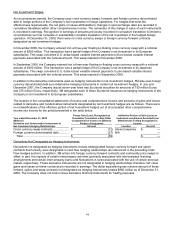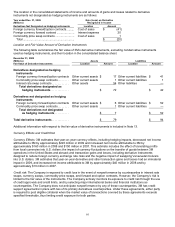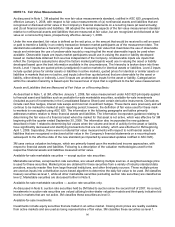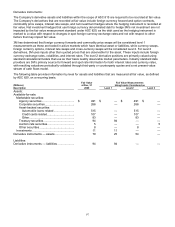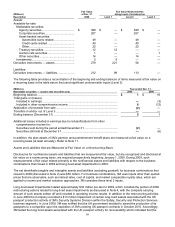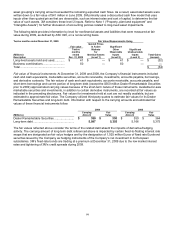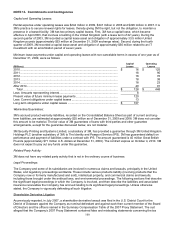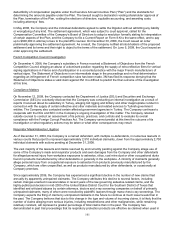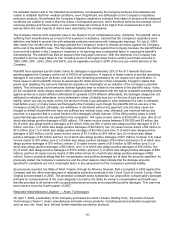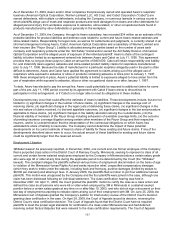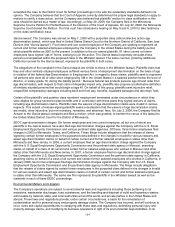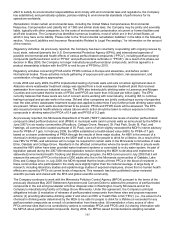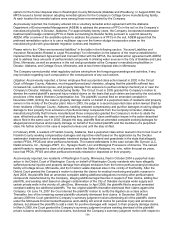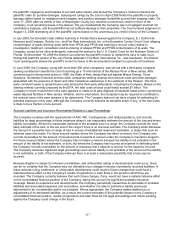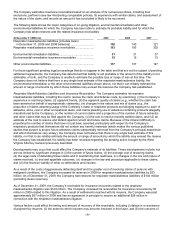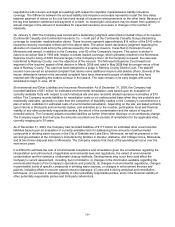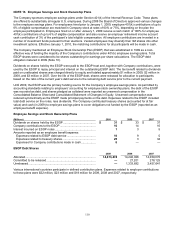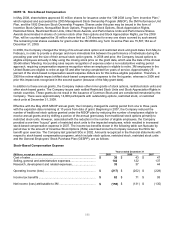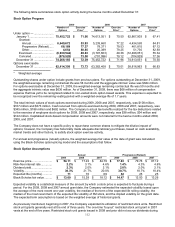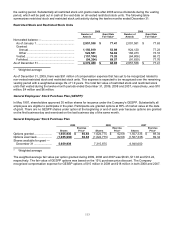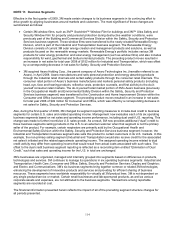3M 2009 Annual Report Download - page 110
Download and view the complete annual report
Please find page 110 of the 2009 3M annual report below. You can navigate through the pages in the report by either clicking on the pages listed below, or by using the keyword search tool below to find specific information within the annual report.
104
remanded the case to the District Court for further proceedings in line with the evidentiary standards defined in its
opinion. The Company believes that the Court of Appeals correctly determined the proper legal standards to apply to
motions to certify a class action, but the Company also believes that plaintiffs’ motion for class certification in this
case should be denied as a matter of law. Accordingly, on May 28, 2009, the Company filed in the Minnesota
Supreme Court a Petition for Partial Review of the Decision of the Court of Appeals. On July 22, 2009, the Minnesota
Supreme Court denied the Petition. The trial court has scheduled a hearing on May 5 and 6, 2010 to take testimony
on the class certification issue.
Garcia lawsuit: The Company was served on May 7, 2009 with a purported class action/collective action age
discrimination lawsuit, which was filed in United States District Court for the Northern District of California, San Jose
Division (the “Garcia lawsuit”). Five former and one current employee of the Company are seeking to represent all
current and former salaried employees employed by the Company in the United States during the liability period,
which plaintiffs define as 2001 to the present. In addition to the six named plaintiffs, 91 other current or former
employees have signed “opt-in” forms, seeking to join the action. The Garcia lawsuit expressly excludes those
persons encompassed within the proposed class in the Whitaker lawsuit. The same counsel, joined by additional
California counsel for the Garcia lawsuit, represents the plaintiffs in both cases.
The allegations of the complaint in the Garcia lawsuit are similar to those in the Whitaker lawsuit. Plaintiffs claim that
they and other similarly situated employees suffered various forms of employment discrimination on the basis of age
in violation of the federal Age Discrimination in Employment Act. In regard to these claims, plaintiffs seek to represent
“all persons who were 46 or older when employed by 3M in the United States in a salaried position below the level of
director, or salary grade 18, during the liability period.” Because federal law protects persons age 40 and older from
age discrimination, with respect to their claim of disparate impact only, plaintiffs also propose an alternative definition
of similarly situated persons that would begin at age 40. On behalf of this group, plaintiffs seek injunctive relief,
unspecified compensatory damages including back and front pay, benefits, liquidated damages and attorneys’ fees.
Certain of the plaintiffs’ and putative class members’ employment terminated under circumstances in which they
were eligible for group severance plan benefits and in connection with those plans they signed waivers of claims,
including age discrimination claims. Plaintiffs claim the waivers of age discrimination claims were invalid in various
respects. This subset of release-signing plaintiffs seeks a declaration that the waivers of age discrimination claims
are invalid, other injunctive, but non-monetary, remedies, and attorneys’ fees. On July 2, 2009, the Company filed its
Answer to the Garcia lawsuit complaint and filed a motion, which was granted, to transfer the venue of the lawsuit to
the United States District Court for the District of Minnesota.
EEOC age-discrimination charges: Six former employees and one current employee, all but one of whom are
plaintiffs in the Garcia lawsuit, have also filed age discrimination charges against the Company with the U.S. Equal
Employment Opportunity Commission and various pertinent state agencies. Of these, three former employees filed
charges in 2005 in Minnesota, Texas, and California. These filings include allegations that the release of claims
signed by certain former employees in the purported class defined in the charges is invalid for various reasons and
assert age discrimination claims on behalf of certain current and former salaried employees in states other than
Minnesota and New Jersey. In 2006, a current employee filed an age discrimination charge against the Company
with the U.S. Equal Employment Opportunity Commission and the pertinent state agency in Missouri, asserting
claims on behalf of a class of all current and certain former salaried employees who worked in Missouri and other
states other than Minnesota and New Jersey. In 2007, a former employee filed an age discrimination charge against
the Company with the U.S. Equal Employment Opportunity Commission and the pertinent state agency in California,
asserting claims on behalf of a class of all current and certain former salaried employees who worked in California. In
January 2009, two former employees filed age discrimination charges against the Company with the U.S. Equal
Employment Opportunity Commission and the pertinent state agency in Minnesota. The filings include allegations
that the release of claims signed by certain former employees in the purported class defined in the charges is invalid
for various reasons and assert age discrimination claims on behalf of certain current and former salaried employees
in states other than Minnesota. The same law firm represents the plaintiffs in the Whitaker lawsuit as well as the
claimants in each of these EEOC proceedings.
Environmental Matters and Litigation
The Company’s operations are subject to environmental laws and regulations including those pertaining to air
emissions, wastewater discharges, toxic substances, and the handling and disposal of solid and hazardous wastes
enforceable by national, state, and local authorities around the world, and private parties in the United States and
abroad. These laws and regulations provide, under certain circumstances, a basis for the remediation of
contamination and for personal injury and property damage claims. The Company has incurred, and will continue to
incur, costs and capital expenditures in complying with these laws and regulations, defending personal injury and
property damage claims, and modifying its business operations in light of its environmental responsibilities. In its


